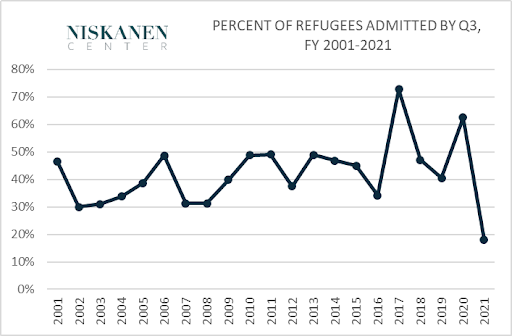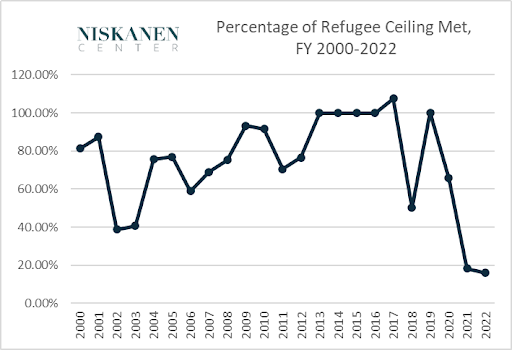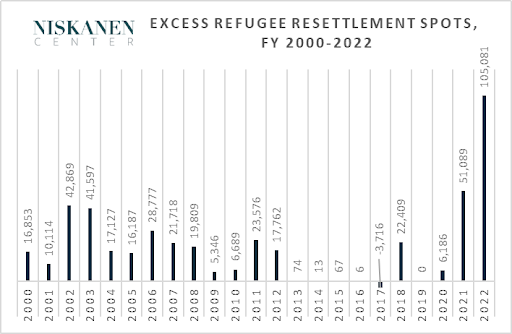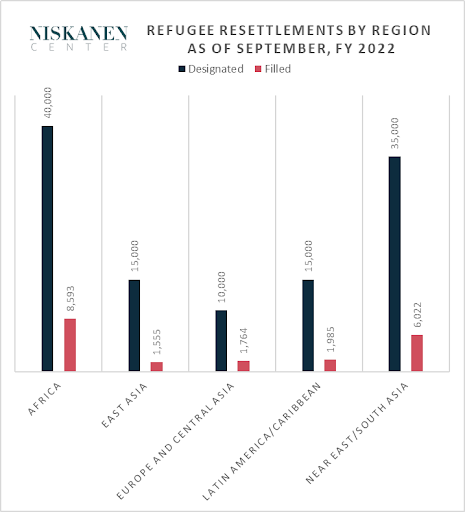Earlier this month, the Biden administration released its proposal for refugee admissions for the coming fiscal year. This year’s report comes during a turbulent period for the refugee resettlement process, with a current shortfall of over 100,000 refugee spots left unfilled and an increasingly predictable tardiness on the part of the executive branch to set refugee targets well in advance or brief members of Congress on them regularly.
These two markers of dysfunction are interconnected. A lack of congressional oversight has enabled successive administrations to disrupt the refugee resettlement process and fail to live up to stated resettlement goals.
By law, Congress must play an active part in determining the overall number of refugees admitted to the United States each year, and the more granular distribution of slots to different global regions, through a process known as consultation. In practice, however, this role often appears perfunctory.
The process
The executive branch’s and Congress’s obligations during consultation are fairly extensive. According to statute, the president must submit a report to the House and Senate judiciary committees that includes a description of the current refugee situation, a detailed plan regarding the number of refugees to be admitted, and an analysis of the impact their resettlement will have on the United States, to name only a few of the required points of information.
The statute also requires that a Cabinet-level member of the administration participate in discussions with members of the committees. These discussions are supposed to be followed by a hearing where Congress members review the recommendations the presidential administration set forth that year. The law also implies that the hearing should be public and in-person. Additionally, it mandates that the information above be submitted to members of Congress at least two weeks before the hearing.
Once the consultation process is complete, the president issues a determination that sets forth the total number of refugees to be admitted along with regional designations. However, the statute leaves no doubt that these steps are meant to be a bare minimum by also requiring “periodic discussions” between representatives of the executive branch and members of the relevant committees.
The spirit of the law is clearly to give Congress a significant degree of oversight in the refugee admission process, which helps hold the executive branch accountable, keep the public informed, and ensure the refugee admissions process remains consistent across presidential administrations. Unfortunately, when Congress plays a diminished role in the consultation process these ends become more difficult to achieve.
A late start has become the standard
One problem Niskanen has previously identified is that the consultation process occurs too late in the fiscal year to allow for significant revisions and is not updated throughout the year. Niskanen recommended having a midyear check-in hearing to ensure the administration is on track to meet the ceiling it established.
The midyear mark matters because the U.S. does not have a good record of admitting enough refugees to fill its annual ceilings, and the pace at six months is a good indicator of full-year performance. Data from the previous 20 fiscal years shows that an average of 42 percent of the total number of refugees admitted in a given fiscal year are admitted by this midyear mark, with some significant variances in recent presidential transition years. Timely congressional intervention could spur the administration to speed up if admissions are lagging, as they have for the previous and current fiscal years.

Niskanen has also recommended that Congress control some allocation of refugee admissions to make the process less political and more stable. Researchers at organizations as divergent as the Heritage Foundation and the Center for American Progress have supported expanding congressional powers in this realm, although they differ significantly on the details.
One way to encourage increased timeliness and congressional involvement would be to add a section to the existing statute that moves the deadlines for the president’s report and consultation hearing earlier in the year and cedes control over the refugee admissions process to Congress if the president misses the reporting deadline, which has occurred in the recent past.
For example, the deadline could be moved to the end of the third quarter instead of two weeks before the end of the fourth quarter. If the president were to miss this deadline, Congress would then be in charge of determining the refugee ceiling within a range of the final ceilings in the last 20 years, which at the time of this writing would entail a high of 85,000, a low of 18,000, and an average of 65,825. The president could still ask to alter this number, but would require congressional approval to do so.
If the consultation and refugee resettlement process were functioning smoothly, reforms of this nature would be unnecessary. Unfortunately, both have seen historical dips in recent years. This ties into another reform Niskanen has recommended: Requiring a public consultation hearing. As stated above, the statute now implies that Congress must hold a public hearing over refugee resettlement numbers unless “the details of the proposal would jeopardize the lives or safety of individuals.”
Ensuring accountability
Despite this language, closed hearings on refugee resettlement have become the standard over the past several years. A potential drawback of making these hearings public is that doing so may increase the risk of turning the consultation process into a spectacle instead of a genuine deliberation, given the emotionally charged nature of the topic.
Nevertheless, a public hearing would be beneficial in increasing public understanding of the resettlement process and holding administrations accountable for shortcomings in their resettlement plans. There are several questions from the previous year alone that defy easy explanations and deserve official responses. For example:
1. Why is the administration set to have the two consecutive worst underperformances in recent refugee admissions history as compared to the ceiling set out in that year’s presidential determination?

The Biden administration has a reasonable, although imperfect, excuse for the numbers in FY 2021, where the ceiling was raised from 15,000 to 62,500 and 72 percent of admissions occurred in the second half of the fiscal year, when his administration had more sway over the process. The administration has offered a similar rationale for this year’s numbers, citing ongoing fallout from the pandemic and cuts made under the Trump administration. Nevertheless, the numbers for this year are a historical and organizational aberration: As of the time of writing, only 16 percent of the ceiling has been met, with over 100,000 spots left unfilled.

While admissions will certainly increase, it is virtually impossible that the Biden administration will come close to meeting its target for FY 2022.
2. Within this gap, there are also regional inequalities. Why is the administration especially underperforming its targets for East Asia, filling only 10 percent of available spots for this region compared to the 16 percent average overall?

3. Why have only 1,200 of the more than 100,000 Ukrainian refugees in the U.S. been received through the traditional refugee process? In contrast, more than 35,000 Ukrainians have entered the country through the private sponsorship program Uniting for Ukraine, with 71,000 others approved.
4. Admissions have been under 70 percent of the ceiling seven times in the past 20 years. What measures would be appropriate for Congress to take in the event that future administrations continue to drastically miss their ceilings?
Conclusion
While the failures of the refugee consultation process have been met with complacency, in previous years there was at least some modicum of stability and efficiency across administrations. In contrast, the past five fiscal years have seen a 20-year high in the refugee ceiling replaced by successive all-time low ceilings, and a subsequent 20-year high ceiling in FY 2022 confirmed again for FY 2023.
This instability has led to five consecutive years where the median number of refugees admitted has been significantly lower than the 21st-century average of approximately 50,000. These trends will have catastrophic humanitarian effects if they are allowed to continue, and only Congress can ensure a long-term path to stability.